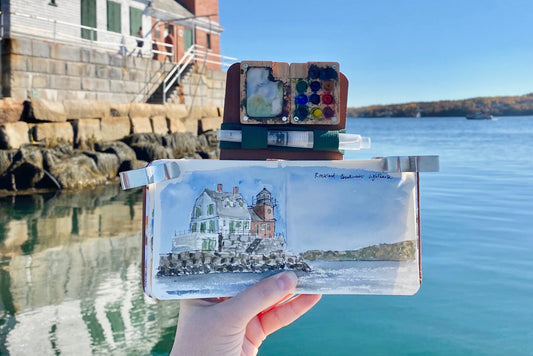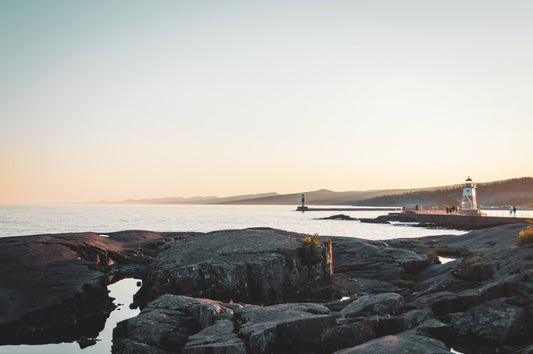
How to Use a Water Brush Pen
Share
If you’re looking to elevate your watercolor painting or bring more flexibility to your art on-the-go, learning how to use a water brush pen is a game-changer! This clever little tool combines a paintbrush and a water container into one compact, refillable tool, making it perfect for travel sketching for artists of all levels. Check out my YouTube video all about water brush pens, including a dissection of the tool!
 The Tool
The Tool
Before we learn how to use this helpful tool, let’s talk about what it actually is. A water brush pen is a self-contained brush with a refillable water tank and a nylon brush tip. Instead of dipping into a separate water container, you squeeze the tank to release water directly into the bristles. Sounds super convenient, right?
Why Use a Water Brush Pen?
While water brush pens aren’t meant to replace your entire brush arsenal, they are incredibly useful in specific scenarios – especially for artists who work on location or in sketchbooks. Water brush pens offer several benefits:
- Portability – No need for a water cup; ideal for plein air painting or travel. If you're interested in learning how to take your art outside, check out my Travel Painting Course where I walk you through the plein air process step-by-step.
- Precision – Great for blending, detail work, and controlled washes.
- Convenience – Easy to clean, refill, and store.
- Beginner-friendly – Less mess and more control than traditional brushes
I like to think of mine as my "paint-anywhere" brushes – they're always ready for an adventure! If you're curious how to make the most of them while traveling, check out my post on the easiest way to sketch your travels.
Brush Options

There are many great options for water brush pens available, depending on your personal preferences. Here are a few that I’ve personally used:
1. Dispowreath
The Dispowreath water brush pen is a mini water brush pen that comes with a small sketchbook – perfect for on-the-go watercolor! It fits easily in my purse alongside the other tools I bring to watercoloring with me wherever I go! It has the thinnest plastic of the three and is the easiest to squeeze. This pen does not have a wick, so water flows quickly from the tank into the bristles.
2. UPINS
This water brush pen comes in a multi-pack with various brush sizes and is the longest water brush pen of the three I feature. It also has the hardest plastic, making it both the best quality and the hardest to squeeze.
3. Funto Art
The water brush pen by Funto Art features a blue water tank that is uniquely shaped to squeeze easily when held. This pen comes in a pack that includes the travel watercolor paint set featured in the video. In the dissection, I found a small wick that controls the water intake into the brush tip. Use the code ALYSSA10OFF for 10% off your purchase.
Go ahead and try all three to find out what you prefer in a water brush pen!
How to Fill and Prep Your Water Brush Pen
Filling it is easier than you think—just unscrew the brush handle (righty-tighty doesn’t always apply here, so try both directions), fill the tank with clean water, and screw it back together. Then, gently squeeze until the water starts to reach the bristles.
Pro Tip: Don’t over-squeeze! A light pressure is enough to keep the brush moist without flooding your page.
Watercolor Painting with a Water Brush Pen
1. Squeeze the pen over a dry watercolor paint square and wipe to wake it up.
2. Try painting with a variety of techniques, including dry brush, wet blending, gradient washes, and line work.
3. To clean the brush, squeeze the tank to let water out, then wipe on a towel. A sweatband worn on the wrist makes for the perfect on-the-go towel!
More Tips
- Consider your location. When painting outside, your watercolor will dry a lot faster due to the wind and heat. This may impact the time you have to blend.
- Let one section dry before beginning another. Wet edges touching wet edges lead to the pigment on the bottom running up to the top.
- Cap the brush when it is not in use to prevent the brush head from getting bent or frayed in your bag. No one wants that!
- Once you are home, take the brush apart, dump the water out, and allow it to air dry completely.

Continue Your Watercolor Journey
Water brush pens open up a whole new world of watercolor possibilities—whether you’re lounging in your backyard or sketching on a hike. Need a spark of creativity? Read my post on Finding Inspiration in Everyday Life to start seeing the world around you in a brand new way.
Want more tips like this? Follow along on my YouTube channel for more beginner-friendly tips, tutorials, and creative ideas to support your watercolor journey–one brushstroke at a time!
Have you tried using a water brush pen? Share your experience with me in the comments! I'd love to hear which style is your favorite and how this tool has allowed you to explore watercolor painting on-the-go! I’m always curious to hear what you’re loving, struggling with, or experimenting on.



